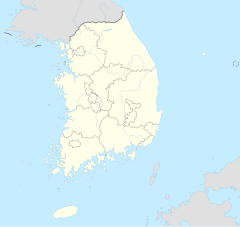| This article does not cite any sources. Please help improve this article by adding citations to reliable sources. Unsourced material may be challenged and removed. Find sources: "Hadong station" – news · newspapers · books · scholar · JSTOR (January 2013) (Learn how and when to remove this message) |
| Hadong Station | |||||
|---|---|---|---|---|---|
| General information | |||||
| Location | South Korea | ||||
| Coordinates | 35°3′49″N 127°45′42″E / 35.06361°N 127.76167°E / 35.06361; 127.76167 | ||||
| Operated by | Korail | ||||
| Line(s) | Gyeongjeon Line | ||||
| Construction | |||||
| Structure type | Aboveground | ||||
| |||||
Hadong Station is a railway station in South Korea located at Bipa-ri, Hadong-eup, Hadong-gun, South Gyeongsang Province. It is on the Gyeongjeon Line. As of 2016 the Mugunghwa-ho train stops at the station eight times a day. From September 27, 2013, the S-Train made four round trips per day, but this was changed in December 2013 to two round trips per day.
Many cherry blossom trees have been planted in a row on the south side of the platform, and in early April, when the cherry blossoms begin to bloom, many tourists flock to the station to take pictures, or for a date.
History
- October 5, 1967: Construction started on the station
- February 7, 1968: Operation commenced as a regular station
- February 29, 1968: Construction completed on the station
- March 26, 1973: Designated as the arrival processing station for civilian-use coal
- May 1, 2006: Handling of parcels suspended
- October 31, 2009: Handling of freight suspended
- September 27, 2013: Became a stop for the S-Train
| Gyeongjeon Line | |
|---|---|
| Main Line |
|
| Boseong-Imseong-ri | |
This article about a railway station in South Korea is a stub. You can help Misplaced Pages by expanding it. |
